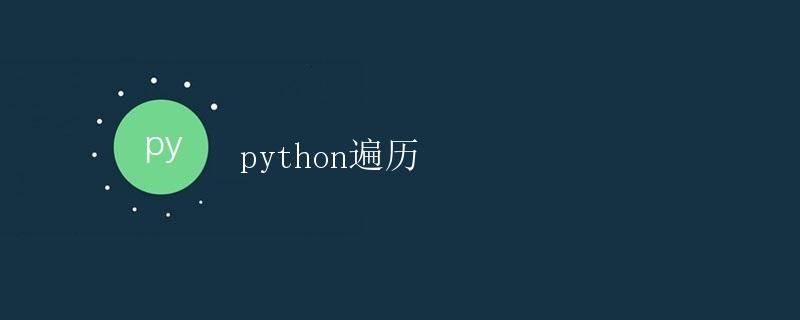Python遍历

1. 介绍
在编程中,遍历是非常常见且重要的操作之一。遍历指的是按照顺序逐个访问集合中的元素。Python提供了多种遍历方式,以满足不同的需求。本文将详细介绍Python中的遍历方法。
2. 遍历列表
Python中的列表是一种有序集合,可以存储任意类型的数据。遍历列表可以通过循环结构实现,常用的有for循环和while循环。
2.1 for循环遍历列表
for循环是一种迭代循环结构,可以依次遍历列表中的每一个元素。
fruits = ['apple', 'banana', 'orange']
for fruit in fruits:
print(fruit)
运行结果:
apple
banana
orange
2.2 while循环遍历列表
while循环也是一种常用的遍历列表的方式,通过不断改变遍历变量的值来实现遍历。
fruits = ['apple', 'banana', 'orange']
index = 0
while index < len(fruits):
print(fruits[index])
index += 1
运行结果:
apple
banana
orange
3. 遍历字典
字典是Python中的一种键值对存储结构,通过键来索引值。遍历字典可以遍历字典的键、值或键值对。
3.1 遍历字典的键
字典的键是唯一且无序的,可以使用for循环遍历字典的键。
person = {'name': 'Alice', 'age': 20, 'gender': 'female'}
for key in person:
print(key)
运行结果:
name
age
gender
3.2 遍历字典的值
使用字典的values()方法可以返回字典中所有的值,然后使用for循环遍历。
person = {'name': 'Alice', 'age': 20, 'gender': 'female'}
for value in person.values():
print(value)
运行结果:
Alice
20
female
3.3 遍历字典的键值对
使用字典的items()方法可以返回字典中所有的键值对,然后使用for循环遍历。
person = {'name': 'Alice', 'age': 20, 'gender': 'female'}
for key, value in person.items():
print(key, value)
运行结果:
name Alice
age 20
gender female
4. 遍历字符串
字符串是Python中的不可变序列,可以通过下标索引来遍历字符串中的每一个字符。
string = 'Hello, World!'
for char in string:
print(char)
运行结果:
H
e
l
l
o
,
W
o
r
l
d
!
5. 遍历元组
元组是一种不可变序列,与列表类似,可以通过循环遍历其中的元素。
fruits = ('apple', 'banana', 'orange')
for fruit in fruits:
print(fruit)
运行结果:
apple
banana
orange
6. 遍历集合
集合是Python中的一种无序的、可变的、不重复的容器,可以通过循环遍历其中的元素。
fruits = {'apple', 'banana', 'orange'}
for fruit in fruits:
print(fruit)
运行结果:
apple
banana
orange
7. 遍历range
range是Python中的一种序列类型,常用于for循环中。可以通过循环遍历其中的数字。
for i in range(5):
print(i)
运行结果:
0
1
2
3
4
8. 遍历文件
在Python中,可以使用open()函数打开一个文件,并通过循环遍历其中的每一行。
with open('data.txt', 'r') as file:
for line in file:
print(line)
运行结果:
Hello, World!
Python is awesome!
9. 自定义遍历函数
除了使用内置的遍历方式,我们还可以自定义遍历函数来实现特定的功能。例如,下面的代码演示了如何遍历一个列表,并将所有元素加倍。
def double(numbers):
for i in range(len(numbers)):
numbers[i] *= 2
numbers = [1, 2, 3, 4, 5]
double(numbers)
print(numbers)
运行结果:
[2, 4, 6, 8, 10]
10. 总结
在本文中,我们详细介绍了Python中的遍历方法。通过遍历,我们可以按照顺序访问集合中的每一个元素。无论是列表、字典、字符串、元组、集合还是range或文件,Python提供了多种遍历方式,以满足不同的需求。同时,我们还可以通过自定义遍历函数来实现特定的功能。
 极客笔记
极客笔记